Model Stirrer Based on a Multi-Material Turntable for Microwave Processing Materials
Abstract
:1. Introduction
2. Methodology
2.1. Model Description
2.2. Multi-Physics Calculation
2.2.1. Governing Equation
2.2.2. Boundary Condition
● Electromagnetic boundary condition
● Heat transfer boundary condition
2.3. Continuous Algorithm for Turntable Rotation
2.4. Experiment Setup
3. Results and Discussion
3.1. Experimental Validation
3.2. Uniformity Analysis
3.2.1. Variations of Electric Field
3.2.2. Hot Spot Analysis
3.2.3. Quantification of Heating Non-Uniformity
4. Conclusions
- (1)
- The computational results from the proposed model are in good agreement with the experiment. It shows that this model can serve as an effective method to deal with the thermal analysis with rotating turntables during microwave heating.
- (2)
- By using various quantitative analysis methods, it can be concluded that multi-material turntables can improve the temperature uniformity of the processed material (increase range: 29%–47%). The amplitude of the improvement, however, is related to the composition of the turntable.
- (3)
- The work will be helpful to optimize the heating status of the existing microwave oven for processing materials.
Acknowledgments
Author Contributions
Conflicts of Interest
References
- Singh, S.; Gupta, D.; Jain, V.; Sharma, A.K. Microwave processing of materials and applications in manufacturing industries: A review. Mater. Manuf. Process. 2015, 30, 1–29. [Google Scholar] [CrossRef]
- Adam, D. Microwave chemistry: Out of the kitchen. Nature 2003, 421, 571–572. [Google Scholar] [CrossRef] [PubMed]
- Tang, J. Unlocking Potentials of Microwaves for Food Safety and Quality. J. Food Sci. 2015, 80, E1776–E1793. [Google Scholar] [CrossRef] [PubMed]
- Mudgett, R.E. Microwave properties and heating characteristics of foods. Food Technol. 1986, 40. [Google Scholar]
- Roy, R.; Agrawal, D.; Cheng, J.; Gedevanishvili, S. Full sintering of powdered-metal bodies in a microwave field. Nature 1990, 399, 668–670. [Google Scholar]
- Liu, Q.; Zhang, M.; Fang, Z.X.; Rong, X.H. Effects of zno nanoparticles and microwave heating on the sterilization and product quality of vacuum-packaged caixin. J. Sci. Food Agric. 2014, 94, 2547–2554. [Google Scholar] [CrossRef] [PubMed]
- Leadbeater, N.E.; Stencel, L.M. Fast, easy preparation of biodiesel using microwave heating. Energy Fuels 2006, 20, 2281–2283. [Google Scholar] [CrossRef]
- Lin, Y.C.; Yang, P.M.; Chen, S.C.; Lin, J.F. Improving biodiesel yields from waste cooking oil using ionic liquids as catalysts with a microwave heating system. Fuel Process. Technol. 2013, 115, 57–62. [Google Scholar] [CrossRef]
- Vadivambal, R.; Jayas, D.S. Non-uniform temperature distribution during microwave heating of food materials—A review. Food Bioprocess Technol. 2010, 3, 161–171. [Google Scholar] [CrossRef]
- Ryynänen, S.; Ohlsson, T. Microwave heating uniformity of ready meals as affected by placement, composition, and geometry. J. Food Sci. 1996, 61, 620–624. [Google Scholar] [CrossRef]
- Kashyap, S.C.; Wyslouzil, W. Methods for improving Heating Uniformity of Microwave Ovens. J. Microw. Power Electromagn. Energy 1977, 12, 224–230. [Google Scholar]
- Zhou, L.; Puri, V.M.; Anantheswaran, R.C.; Yeh, G. Finite element modeling of heat and mass transfer in food materials during microwave heating-model development and validation. J. Food Eng. 1995, 25, 509–529. [Google Scholar] [CrossRef]
- Sebera, V.; Nasswettrová, A.; Nikl, K. Finite element analysis of mode stirrer impact on electric field uniformity in a microwave applicator. Dry. Technol. 2012, 30, 1388–1396. [Google Scholar] [CrossRef]
- Plaza-González, P.; Monzó-Cabrera, J.; Catalá-Civera, J.M.; Sánchez-Hernández, D. New approach for the prediction of the electric field distribution in multimode microwave-heating applicators with mode stirrers. IEEE Trans. Magn. 2004, 40, 1672–1678. [Google Scholar] [CrossRef]
- Plaza-González, P.; Monzó-Cabrera, J.; Catalá-Civera, J.M.; Sánchez-Hernández, D. Effect of mode-stirrer configurations on dielectric heating performance in multimode microwave applicators. IEEE Trans. Microw. Theory Technol. 2005, 53, 1699–1706. [Google Scholar] [CrossRef]
- Geedipalli, S.S.R.; Rakesh, V.; Datta, A.K. Modeling the heating uniformity contributed by a rotating turntable in microwave ovens. J. Food Eng. 2007, 82, 359–368. [Google Scholar] [CrossRef]
- Liu, S.; Fukuoka, M.; Sakai, N. A finite element model for simulating temperature distributions in rotating food during microwave heating. J. Food Eng. 2013, 115, 49–62. [Google Scholar] [CrossRef]
- Pitchai, K.; Chen, J.; Birla, S.; Gonzalez, R.; Jones, D.; Subbiah, J. A microwave heat transfer model for a rotating multi-component meal in a domestic oven: Development and validation. J. Food Eng. 2014, 128, 60–71. [Google Scholar] [CrossRef]
- Kaye, G.W.C.; Laby, T.H. Tables of Physical and Chemical Constants, 15th ed.; World Book Inc.: New York, NY, USA, 1995. [Google Scholar]
- Torres, F.; Jecko, B. Complete FDTD analysis of microwave heating processes in frequency-dependent and temperature-dependent media. IEEE Trans. Microw. Theory Technol. 1997, 45, 108–117. [Google Scholar] [CrossRef]
- Goldblith, S.A.; Wang, D.I.C. Effect of microwaves on escherichia coli and bacillus subtilis. Appl. Microbiol. 1967, 15, 1371–1375. [Google Scholar] [PubMed]
- Huang, K.M.; Liao, Y.H. Transient power loss density of electromagnetic pulse in debye media. IEEE Trans. Microw. Theory Technol. 2015, 63, 135–140. [Google Scholar] [CrossRef]
- Pandit, R.B.; Prasad, S. Finite element analysis of microwave heating of potato––transient temperature profiles. J. Food Eng. 2003, 60, 193–202. [Google Scholar] [CrossRef]
- Pitchai, K.; Birla, S.L.; Subbiah, J.; Jones, D.; Thippareddi, H. Coupled electromagnetic and heat transfer model for microwave heating in domestic ovens. J. Food Eng. 2012, 112, 100–111. [Google Scholar] [CrossRef]
- Zhou, P.; Yang, X.; Huang, K.; Jia, G. A microwave-assisted continuous flow reactor based on ridged waveguide. Chem. Eng. Technol. 2015, 38, 1334–1339. [Google Scholar] [CrossRef]
- Wang, Y.; Wig, T.D.; Tang, J.; Hallberg, L.M. Dielectric properties of foods relevant to RF and microwave pasteurization and sterilization. J. Food Eng. 2003, 57, 257–268. [Google Scholar] [CrossRef]
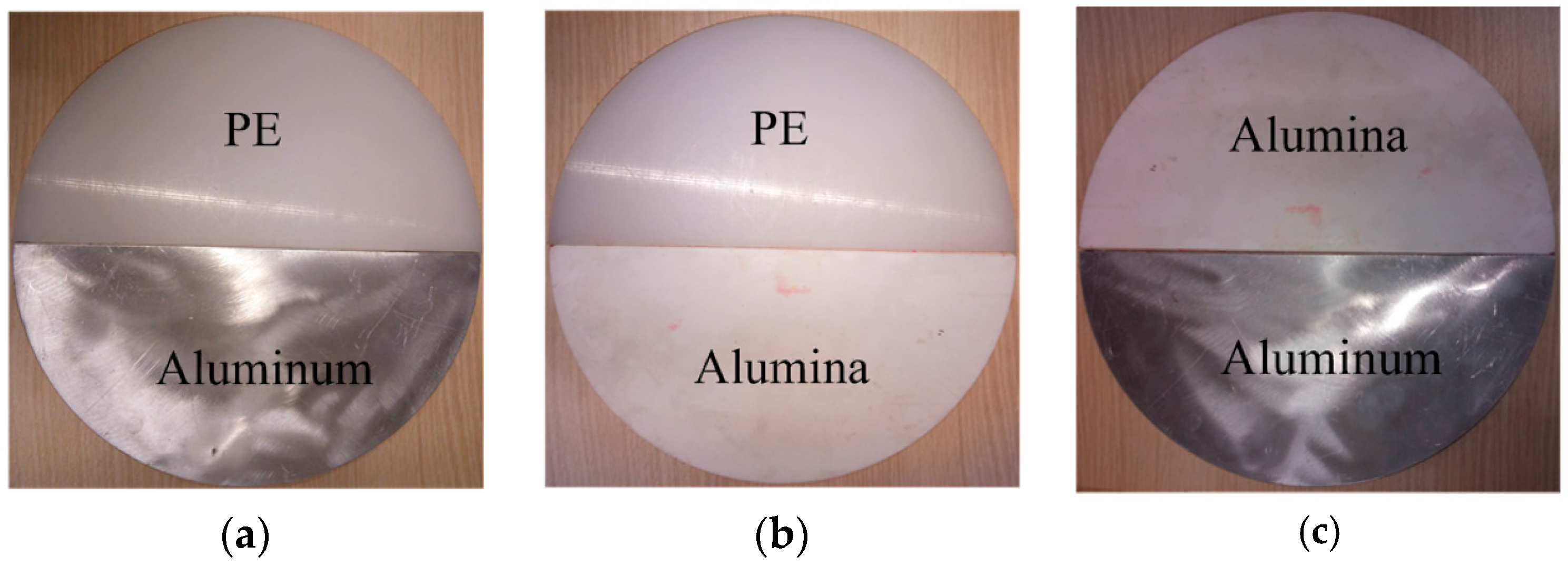
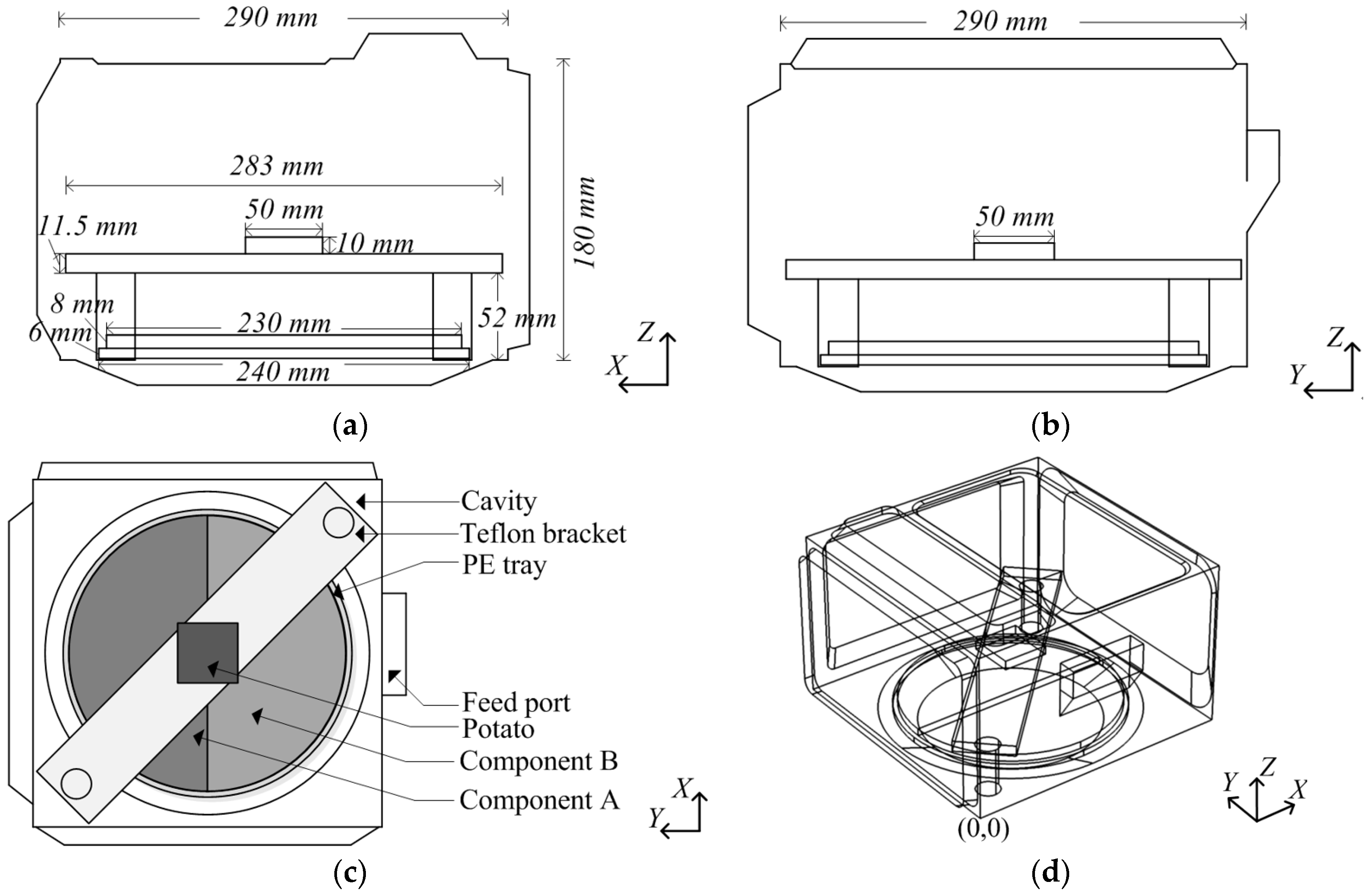
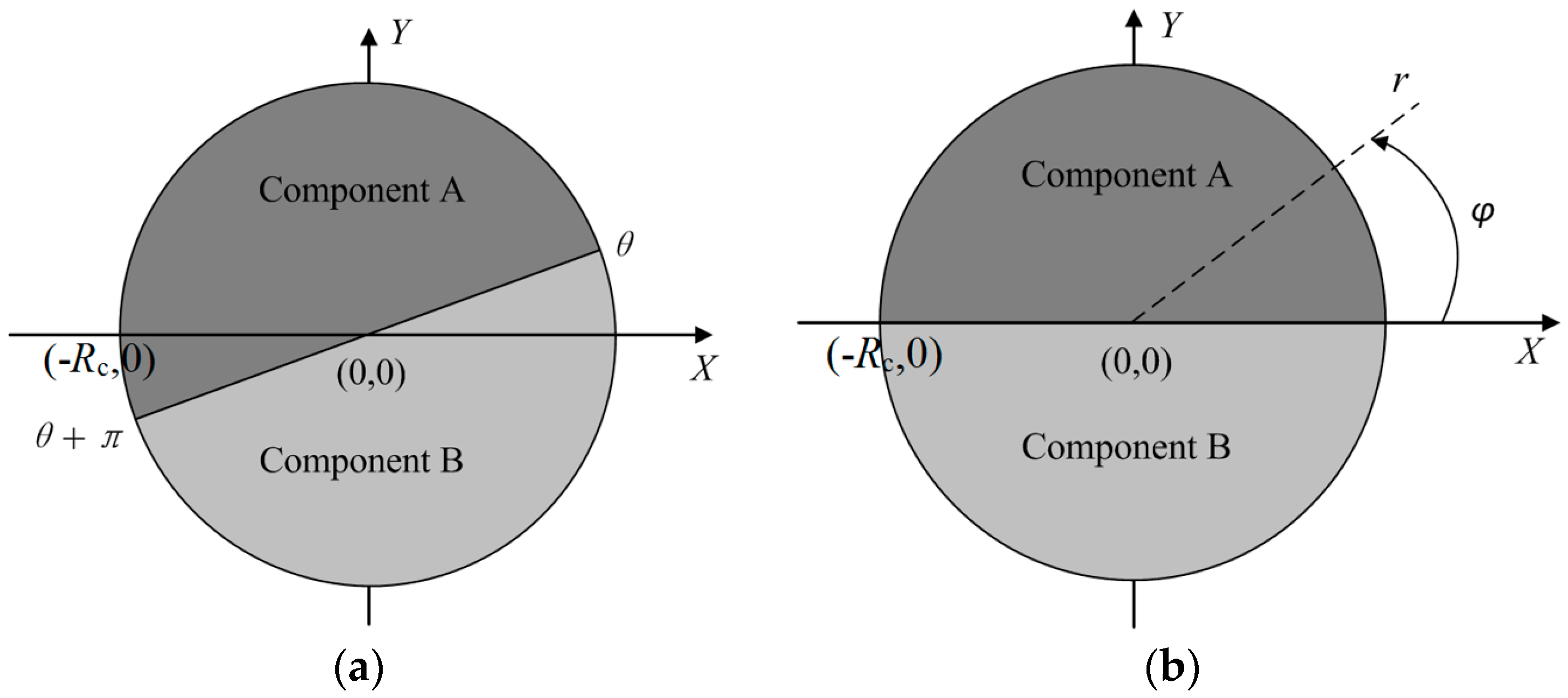
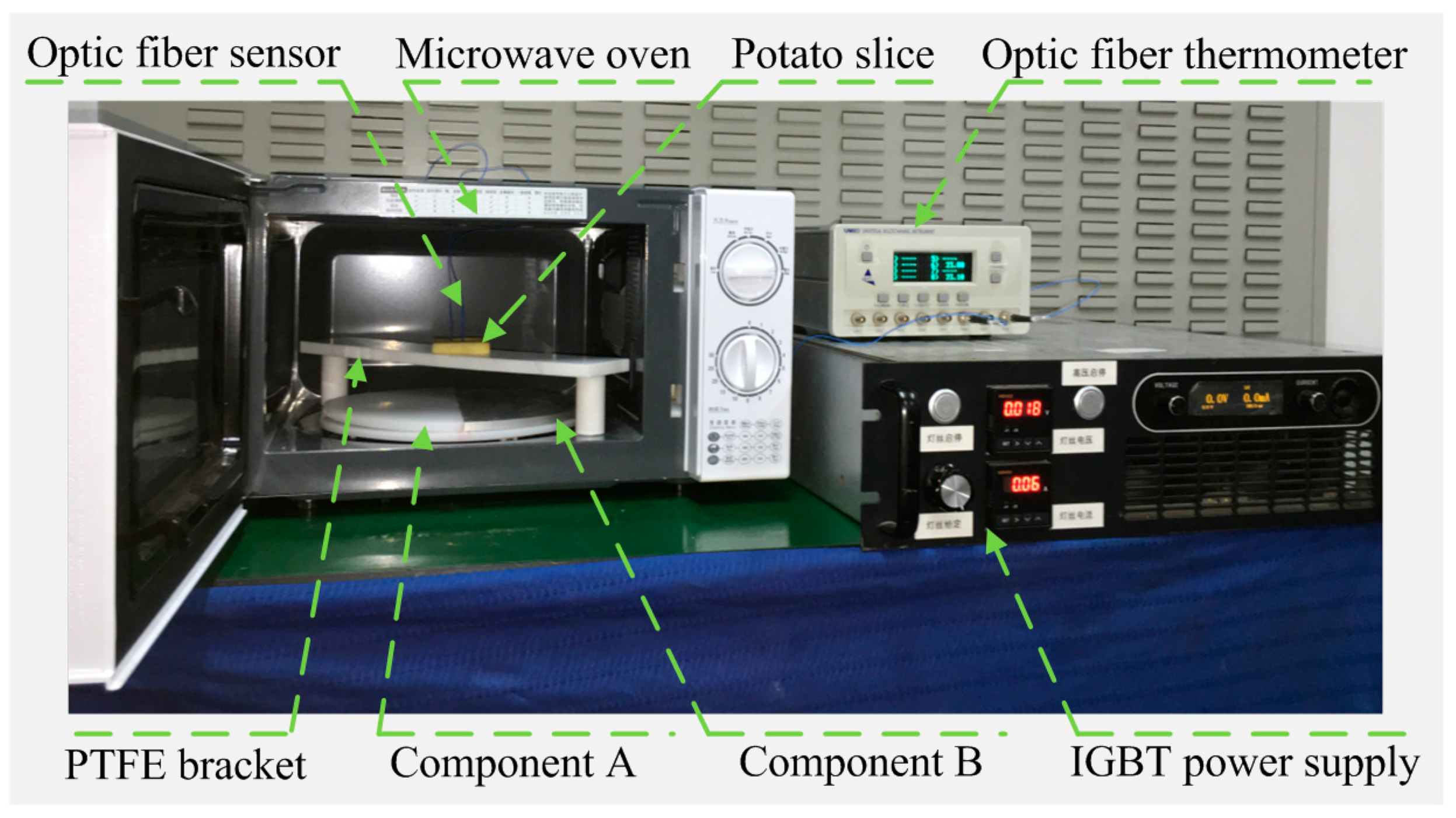
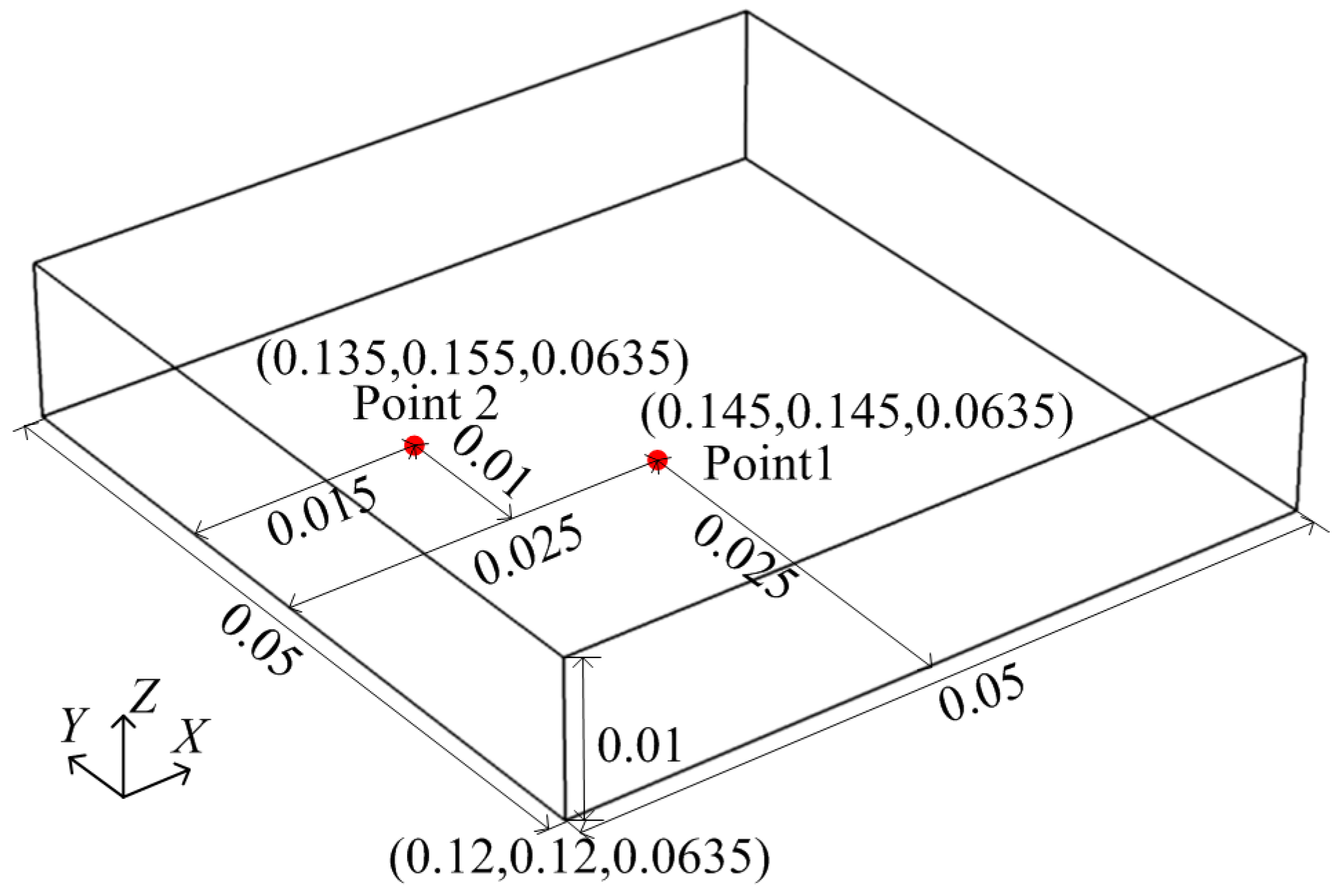
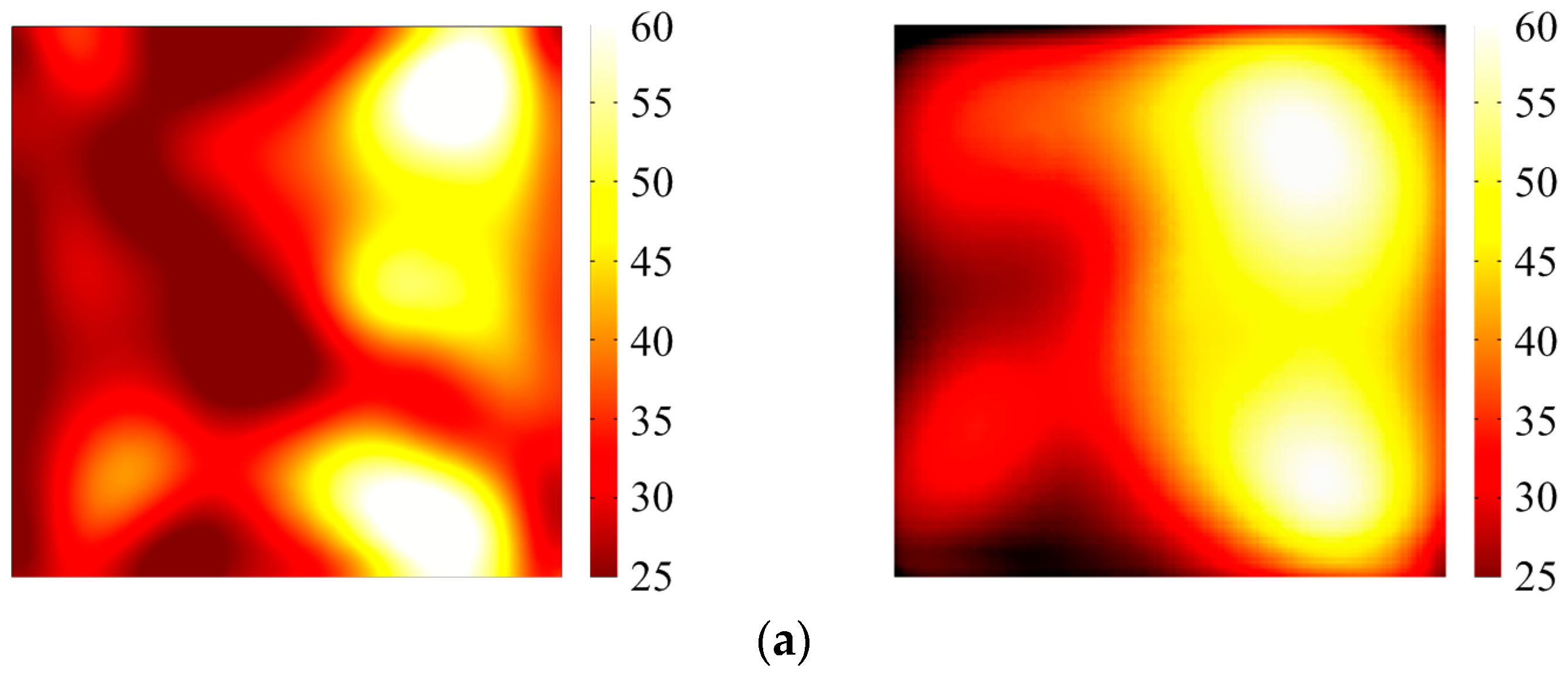

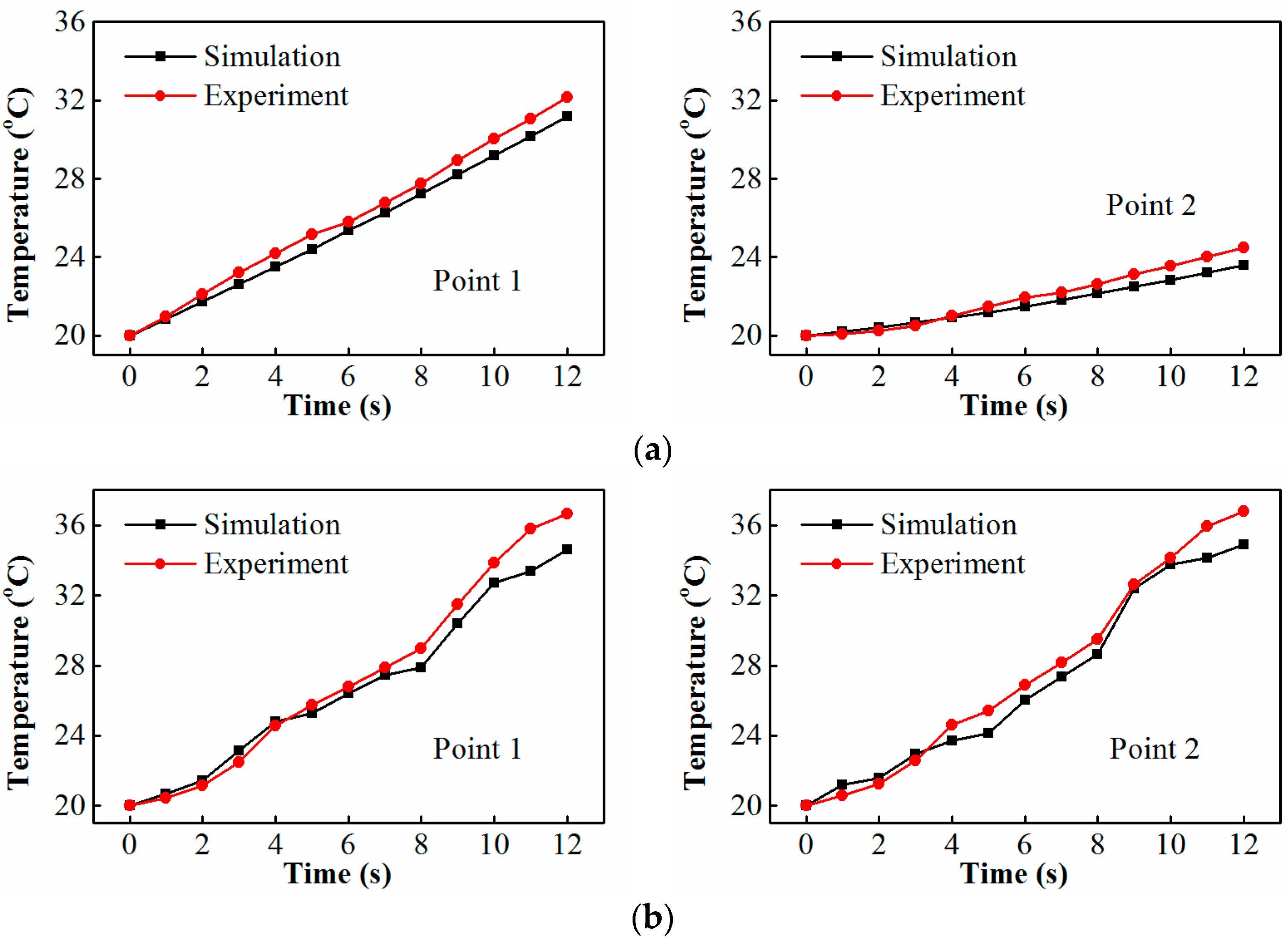
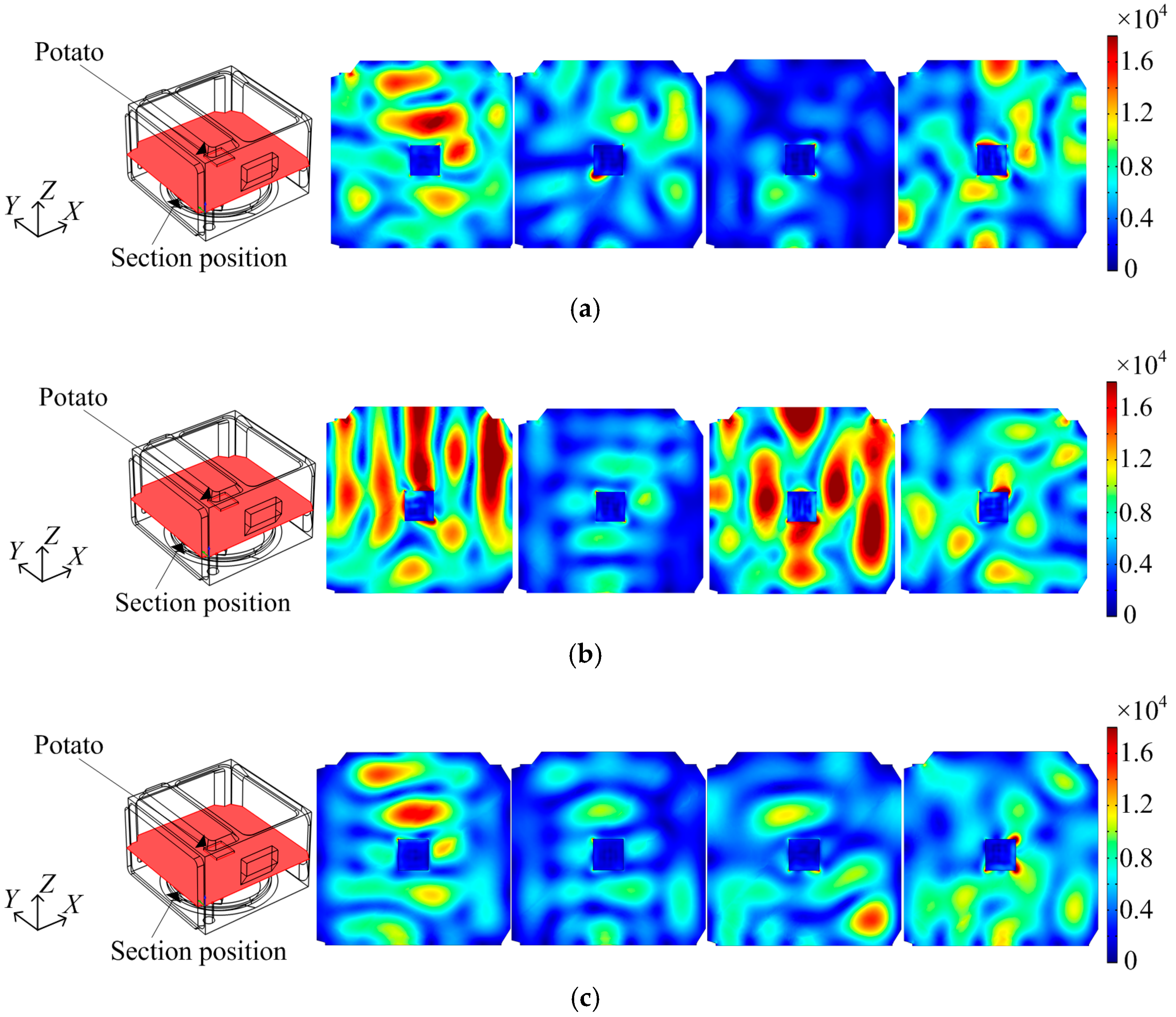
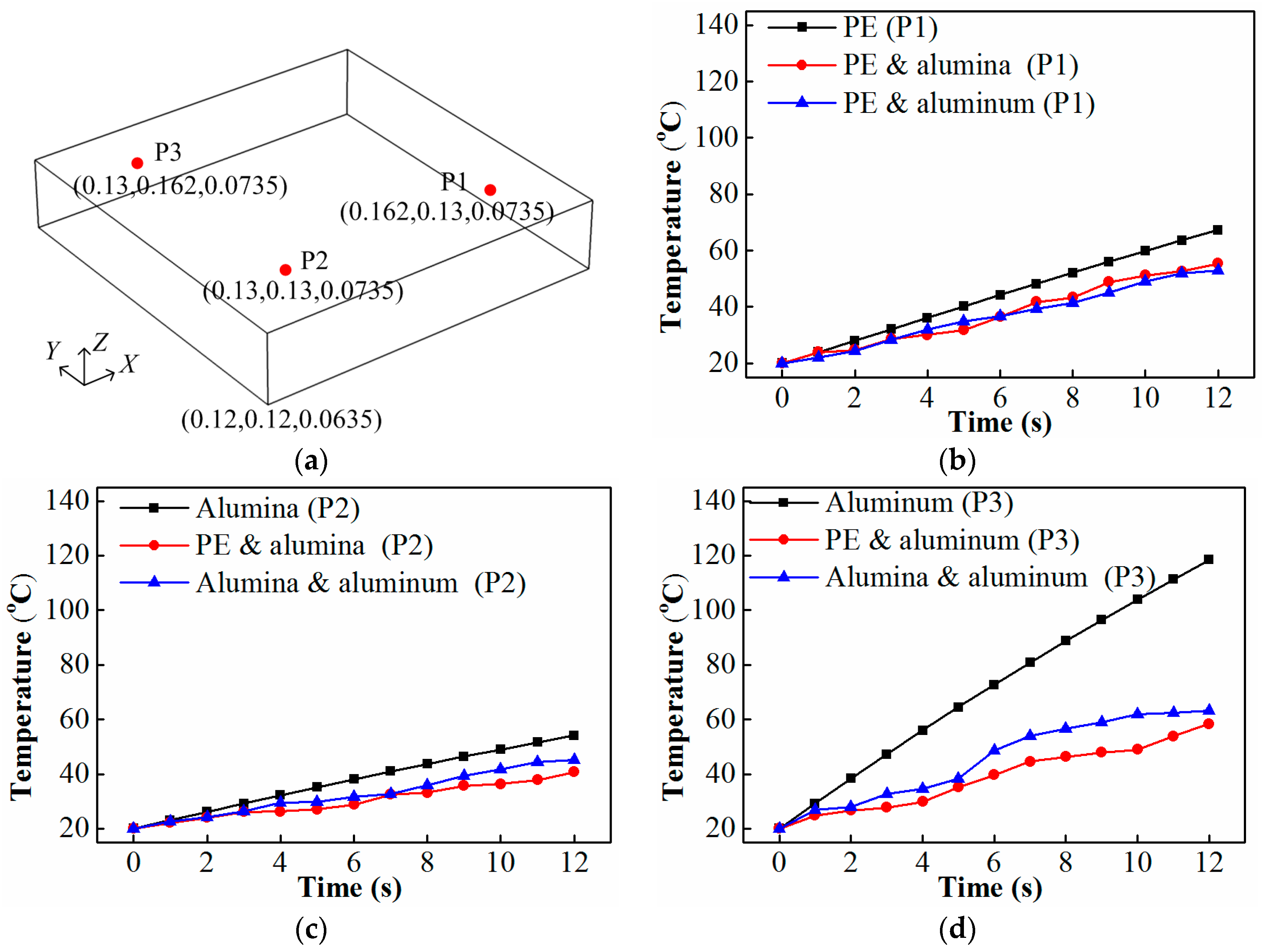
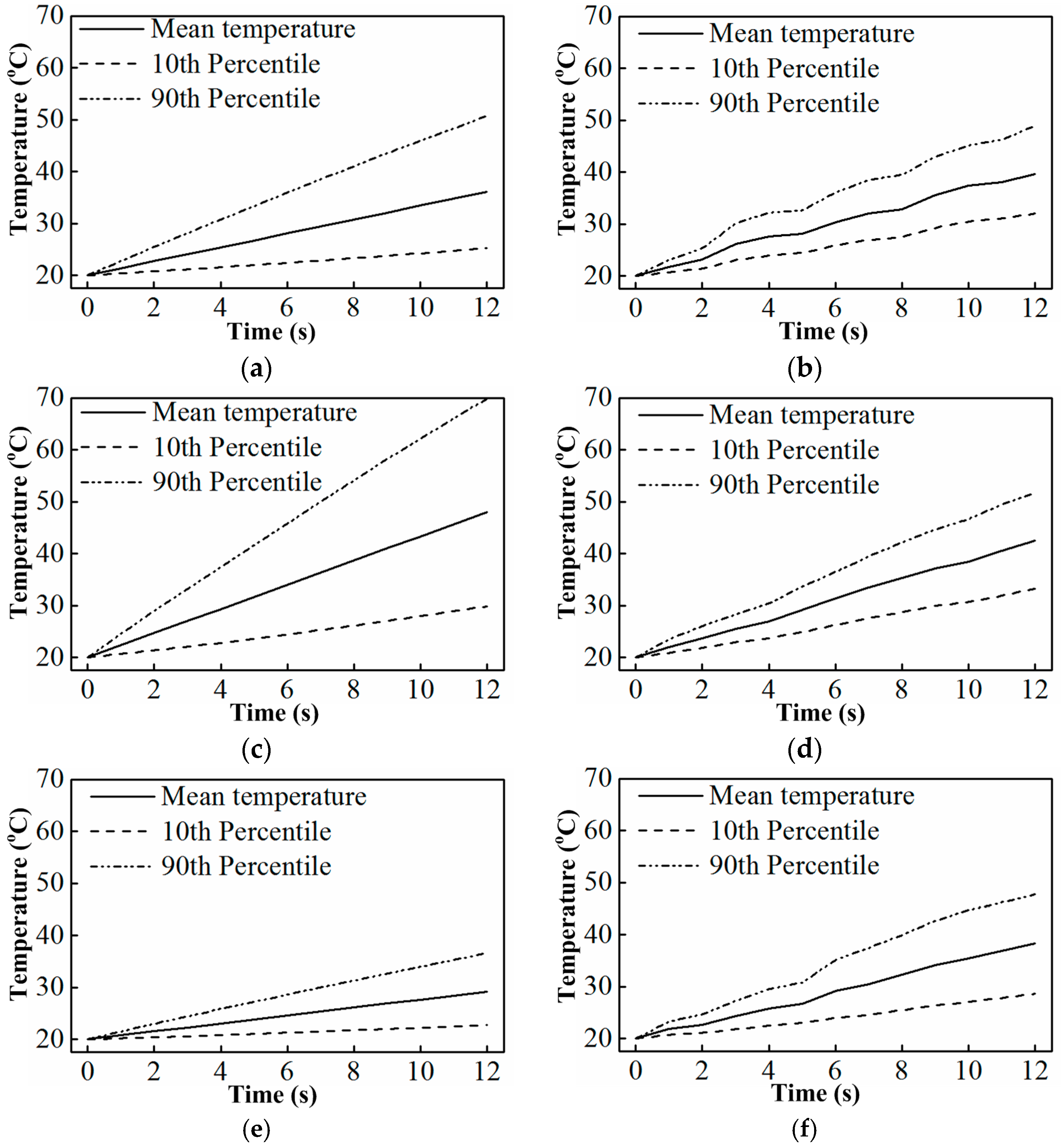
| Parameter | Domains | Value |
|---|---|---|
| Dielectric constant (ε′) | Air | 1 |
| Alumina | 9 | |
| PE | 2.3 | |
| Aluminum | 1 | |
| Teflon | 2.1 | |
| Potato | 57 | |
| Dielectric loss factor (ε′′) | Potato | 17 |
| Others | 0 | |
| Specific heat capacity (Cp, J/(kg·K)) | Potato | 3640 |
| Density (ρ, kg/m3) | Potato | 1050 |
| Thermal conductivity (k, W/(m3·K)) | Potato | 0.648 |
| Heat transfer coefficient (h, W/(m2·K)) | Potato–Air | 10 |
| Electrical conductivity (S/m) | Aluminum | 3.774 × 107 |
| Others | 0 |
| Parameter | PE | Alumina | Aluminum | PE and Alumina | PE and Aluminum | Alumina and Aluminum |
|---|---|---|---|---|---|---|
| Mean Temperature Rise (°C) | 16.13 | 9.20 | 27.99 | 19.64 | 22.46 | 16.86 |
| Standard Deviation (°C) | 10.80 | 5.75 | 16.37 | 6.52 | 7.11 | 6.96 |
| COV | 0.670 | 0.625 | 0.585 | 0.332 | 0.317 | 0.413 |
| Parameter | PE | Alumina | Aluminum | PE and Alumina | PE and Aluminum | Alumina and Aluminum |
|---|---|---|---|---|---|---|
| 10th Percentile (°C) | 25.20 | 22.74 | 29.86 | 32.02 | 33.24 | 27.93 |
| 90th Percentile (°C) | 50.88 | 36.59 | 69.91 | 48.97 | 51.66 | 45.9 |
| Difference (°C) | 25.68 | 13.85 | 40.05 | 16.95 | 18.43 | 17.97 |
| Mean Temperature Rise (°C) | 16.13 | 9.20 | 27.99 | 19.64 | 22.46 | 16.86 |
| Difference/Rise | 1.589 | 1.505 | 1.432 | 0.863 | 0.820 | 1.066 |
© 2017 by the authors. Licensee MDPI, Basel, Switzerland. This article is an open access article distributed under the terms and conditions of the Creative Commons Attribution (CC BY) license ( http://creativecommons.org/licenses/by/4.0/).
Share and Cite
Ye, J.; Hong, T.; Wu, Y.; Wu, L.; Liao, Y.; Zhu, H.; Yang, Y.; Huang, K. Model Stirrer Based on a Multi-Material Turntable for Microwave Processing Materials. Materials 2017, 10, 95. https://doi.org/10.3390/ma10020095
Ye J, Hong T, Wu Y, Wu L, Liao Y, Zhu H, Yang Y, Huang K. Model Stirrer Based on a Multi-Material Turntable for Microwave Processing Materials. Materials. 2017; 10(2):95. https://doi.org/10.3390/ma10020095
Chicago/Turabian StyleYe, Jinghua, Tao Hong, Yuanyuan Wu, Li Wu, Yinhong Liao, Huacheng Zhu, Yang Yang, and Kama Huang. 2017. "Model Stirrer Based on a Multi-Material Turntable for Microwave Processing Materials" Materials 10, no. 2: 95. https://doi.org/10.3390/ma10020095







